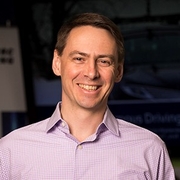- Level Expert
- Duration 27 hours
- Course by University of Toronto
-
Offered by

About
Welcome to State Estimation and Localization for Self-Driving Cars, the second course in University of Toronto's Self-Driving Cars Specialization. We recommend you take the first course in the Specialization prior to taking this course. This course will introduce you to the different sensors and how we can use them for state estimation and localization in a self-driving car. By the end of this course, you will be able to: - Understand the key methods for parameter and state estimation used for autonomous driving, such as the method of least-squares - Develop a model for typical vehicle localization sensors, including GPS and IMUs - Apply extended and unscented Kalman Filters to a vehicle state estimation problem - Understand LIDAR scan matching and the Iterative Closest Point algorithm - Apply these tools to fuse multiple sensor streams into a single state estimate for a self-driving car For the final project in this course, you will implement the Error-State Extended Kalman Filter (ES-EKF) to localize a vehicle using data from the CARLA simulator. This is an advanced course, intended for learners with a background in mechanical engineering, computer and electrical engineering, or robotics. To succeed in this course, you should have programming experience in Python 3.0, familiarity with Linear Algebra (matrices, vectors, matrix multiplication, rank, Eigenvalues and vectors and inverses), Statistics (Gaussian probability distributions), Calculus and Physics (forces, moments, inertia, Newton's Laws).Modules
Introduction to State Estimation and Localization for Self-Driving Cars
1
Discussions
- Get to Know Your Classmates
2
Videos
- Welcome to the Self-Driving Cars Specialization!
- Welcome to the Course
3
Readings
- Course Prerequisites: Knowledge, Hardware & Software
- How to Use Discussion Forums
- How to Use Supplementary Readings in This Course
Meet the Self-Driving Car Experts
7
Videos
- Meet the Instructor, Jonathan Kelly
- Meet the Instructor, Steven Waslander
- Meet Diana, Firmware Engineer
- Meet Winston, Software Engineer
- Meet Andy, Autonomous Systems Architect
- Meet Paul Newman, Founder, Oxbotica & Professor at University of Oxford
- The Importance of State Estimation
Least Squares
1
Assignment
- Lesson 1: Practice Quiz
1
Labs
- Lesson 1 Practice Notebook: Least Squares
2
Videos
- Lesson 1 (Part 1): Squared Error Criterion and the Method of Least Squares
- Lesson 1 (Part 2): Squared Error Criterion and the Method of Least Squares
1
Readings
- Lesson 1 Supplementary Reading: The Squared Error Criterion and the Method of Least Squares
Recursive Least Squares
1
Assignment
- Lesson 2: Practice Quiz
1
Labs
- Lesson 2 Practice Notebook: Recursive Least Squares
2
Videos
- Lesson 2: Recursive Least Squares
- Lesson 3: Least Squares and the Method of Maximum Likelihood
2
Readings
- Lesson 2 Supplementary Reading: Recursive Least Squares
- Lesson 3 Supplementary Reading: Least Squares and the Method of Maximum Likelihood
Weekly Assignment
1
Assignment
- Module 1: Graded Quiz
The Linear Kalman Filter
2
Videos
- Lesson 1: The (Linear) Kalman Filter
- Lesson 2: Kalman Filter and The Bias BLUEs
2
Readings
- Lesson 1 Supplementary Reading: The Linear Kalman Filter
- Lesson 2 Supplementary Reading: The Kalman Filter - The Bias BLUEs
The Nonlinear Kalman Filter
4
Videos
- Lesson 3: Going Nonlinear - The Extended Kalman Filter
- Lesson 4: An Improved EKF - The Error State Extended Kalman Filter
- Lesson 5: Limitations of the EKF
- Lesson 6: An Alternative to the EKF - The Unscented Kalman Filter
3
Readings
- Lesson 3 Supplementary Reading: Going Nonlinear - The Extended Kalman Filter
- Lesson 4 Supplementary Reading: An Improved EKF - The Error State Kalman FIlter
- Lesson 6 Supplementary Reading: An Alternative to the EKF - The Unscented Kalman Filter
Weekly Assignment
- Module 2 Graded Notebook (Submission): Estimating a Vehicle Trajectory
1
Labs
- Module 2 Graded Notebook: Estimating a Vehicle Trajectory
GNSS/INS Sensing for Pose Estimation
3
Videos
- Lesson 1: 3D Geometry and Reference Frames
- Lesson 2: The Inertial Measurement Unit (IMU)
- Lesson 3: The Global Navigation Satellite Systems (GNSS)
3
Readings
- Lesson 1 Supplementary Reading: 3D Geometry and Reference Frames
- Lesson 2 Supplementary Reading: The Inertial Measurement Unit (IMU)
- Lesson 3 Supplementary Reading: The Global Navigation Satellite System (GNSS)
Learn from Industry Experts
1
Videos
- Why Sensor Fusion?
Weekly Assignment
1
Assignment
- Module 3: Graded Quiz
LIDAR Sensing
3
Videos
- Lesson 1: Light Detection and Ranging Sensors
- Lesson 2: LIDAR Sensor Models and Point Clouds
- Lesson 3: Pose Estimation from LIDAR Data
3
Readings
- Lesson 1 Supplementary Reading: Light Detection and Ranging Sensors
- Lesson 2 Supplementary Reading: LIDAR Sensor Models and Point Clouds
- Lesson 3 Supplementary Reading: Pose Estimation from LIDAR Data
Learn from Industry Experts
1
Videos
- Optimizing State Estimation
Weekly Assignment
1
Quiz
- Module 4: Graded Quiz
State Estimation in Practice
4
Videos
- Lesson 1: State Estimation in Practice
- Lesson 2: Multisensor Fusion for State Estimation
- Lesson 3: Sensor Calibration - A Necessary Evil
- Lesson 4: Loss of One or More Sensors
2
Readings
- Lesson 2 Supplementary Reading: Multisensor Fusion for State Estimation
- Lesson 3 Supplementary Reading: Sensor Calibration - A Necessary Evil
Learn from Industry Experts
1
Videos
- The Challenges of State Estimation
Final Project: Vehicle State Estimation on a Roadway
- Final Project: Vehicle State Estimation on a Roadway
2
Videos
- Final Lesson: Project Overview
- Final Project Solution [LOCKED]
Lesson 3 - Congratulations!
1
Discussions
- Your Learning Journey
1
Videos
- Congratulations on Completing Course 2!
Auto Summary
Dive into the advanced realm of self-driving cars with the "State Estimation and Localization for Self-Driving Cars" course by the University of Toronto. This expert-level course covers key methods like least-squares, Kalman Filters, and LIDAR scan matching, using sensors such as GPS and IMUs. Ideal for those with a background in engineering or robotics, and Python programming skills, it culminates in a hands-on project using the CARLA simulator. Offered on Coursera with various subscription options, this course spans 1620 minutes, perfect for dedicated learners aiming to master autonomous vehicle localization.

Jonathan Kelly

Steven Waslander


